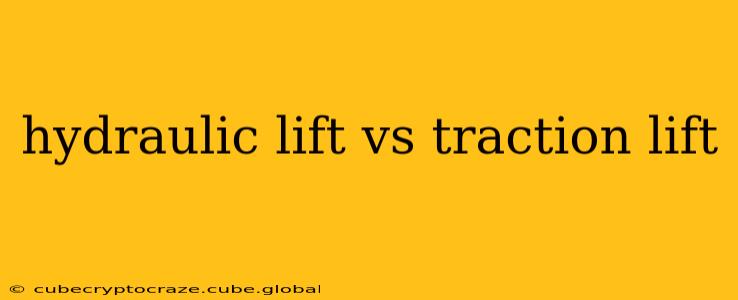Choosing between a hydraulic lift and a traction lift for your elevator needs depends heavily on factors like building height, budget, and desired speed. Both systems achieve the same goal – transporting people or goods vertically – but they accomplish this through vastly different mechanisms. This comprehensive guide will delve into the key differences, advantages, and disadvantages of each, helping you make an informed decision.
What is a Hydraulic Lift?
Hydraulic lifts utilize a hydraulic cylinder to move the elevator car. A pump pressurizes hydraulic fluid, forcing a piston within the cylinder to extend, raising the car. Conversely, releasing the pressure allows the car to descend, either through controlled release or gravity. These systems typically feature a hydraulic cylinder located in a pit beneath the elevator shaft.
Advantages of Hydraulic Lifts:
- Simpler Design & Lower Initial Cost: Generally, hydraulic lifts are less complex than traction lifts, resulting in lower initial installation costs. This is especially true for low-rise buildings.
- Compact Machinery: The hydraulic pump and cylinder are usually located in a pit below the elevator shaft, reducing the need for significant headroom space compared to traction lifts.
- Good for Low-Rise Buildings: They are highly efficient for shorter travel distances, making them a cost-effective choice for buildings with fewer floors.
- Smooth Starts and Stops: Hydraulic lifts often offer smoother starts and stops due to the nature of hydraulic fluid's controlled movement.
Disadvantages of Hydraulic Lifts:
- Limited Speed & Height: Hydraulic lifts struggle to achieve high speeds and are not practical for tall buildings. The limitations stem from the pressure requirements needed to lift the car over greater distances.
- Energy Inefficiency: These systems tend to be less energy-efficient than traction lifts, particularly for frequent use, as energy is lost through friction and heat.
- Environmental Concerns: Hydraulic fluid can be environmentally harmful, requiring careful handling and disposal. Modern systems utilize more eco-friendly fluids.
- Pit Requirement: Requires a deep pit below the elevator shaft, potentially increasing excavation costs and limiting installation flexibility.
What is a Traction Lift?
Traction lifts utilize counterweights and steel ropes (or belts) wrapped around a motor-driven sheave (pulley) to move the elevator car. The motor rotates the sheave, raising or lowering the car. The counterweight balances the car's weight, reducing the energy required to move it.
Advantages of Traction Lifts:
- High Speed & Height Capability: They can achieve much higher speeds and are suitable for tall buildings due to their efficient use of counterweights and the absence of pressure limitations.
- Energy Efficiency: Traction lifts are generally more energy-efficient than hydraulic lifts, especially in tall buildings with high usage. Regenerative systems can even return energy back to the building's power grid during descent.
- Environmentally Friendly: They avoid the environmental concerns associated with hydraulic fluids.
- Less Maintenance: Compared to hydraulic lifts, traction lifts typically require less frequent maintenance.
Disadvantages of Traction Lifts:
- Higher Initial Cost: The more complex design and components make traction lifts more expensive to install than hydraulic lifts.
- Higher Headroom Requirements: They need more headroom space due to the sheave and other machinery located at the top of the elevator shaft.
- Machine Room Required: Usually require a dedicated machine room to house the motor and other components. This can add to construction costs and space constraints.
- More Complex Maintenance: Although less frequent, maintenance can be more complex than for hydraulic systems.
Hydraulic Lift vs. Traction Lift: Which is Right for You?
The best choice depends entirely on your specific needs:
- Low-rise buildings (up to 5 stories): Hydraulic lifts are often more cost-effective.
- High-rise buildings (6 stories and above): Traction lifts are essential for their speed and capacity.
- Budget: Hydraulic lifts generally have lower initial costs.
- Energy efficiency: Traction lifts are more energy-efficient in the long run.
- Space constraints: Hydraulic lifts require less headroom but need a deep pit.
This comparison should help clarify the differences between hydraulic and traction lifts, enabling you to choose the system that best suits your building’s requirements. Consulting with an elevator specialist is highly recommended for a personalized assessment.
Frequently Asked Questions (Based on "People Also Ask" searches)
What is the difference between a hydraulic elevator and a traction elevator? The core difference lies in their operating mechanisms. Hydraulic elevators use pressurized fluid to move the car, while traction elevators use cables and counterweights.
Which is more efficient, hydraulic or traction elevator? Traction elevators are generally more energy-efficient, particularly in high-rise buildings, due to their use of counterweights and regenerative braking systems.
Which type of elevator is better for high-rise buildings? Traction elevators are far better suited for high-rise buildings because of their higher speed and capacity.
What are the pros and cons of hydraulic elevators? Pros include lower initial cost and compact machinery; cons include limited speed and height, energy inefficiency, and environmental concerns regarding the hydraulic fluid.
What are the pros and cons of traction elevators? Pros include high speed and capacity, energy efficiency, and environmental friendliness; cons include higher initial cost, greater headroom requirements, and the need for a machine room.
Are hydraulic elevators cheaper than traction elevators? Typically, yes, hydraulic elevators have lower initial installation costs, especially for low-rise buildings.
How do hydraulic elevators work? They use a hydraulic pump to pressurize fluid, which then forces a piston to move the elevator car.
How do traction elevators work? They use cables and a counterweight system to move the elevator car, with a motor driving the sheave (pulley) to which the cables are attached.
